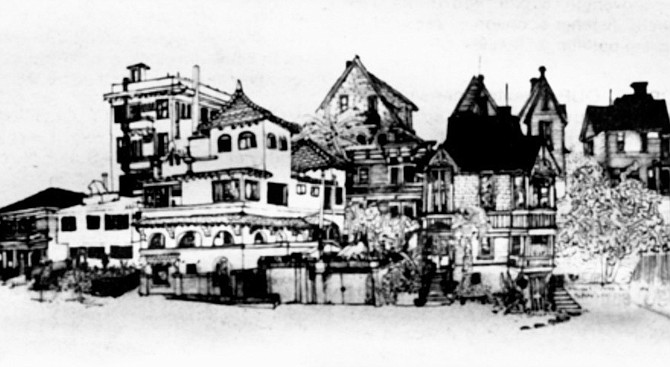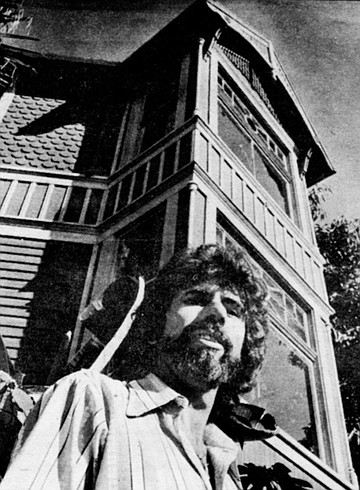 Facebook
Facebook
 X
X
 Instagram
Instagram
 TikTok
TikTok
 Youtube
Youtube

San Diego — what to do: where to live? I remembered an old house I had once drawn. It was a crumbly thing down in a cut-off piece of San Diego. The area consisted of strange pieces of leftover Victoriana and looming Spanish Mansion: Front Street. I drove down there one day just to say hello to one of the old buildings. There was a step-ladder in the upstairs bay window. The ladder was alone and looked out across “wop town" into the San Diego Bay and beyond, past North Island, Point Loma, even as far as Los Coronados out in the Pacific. I knew it was a special place where this building sat. On the corner of First Avenue and Fir Street, on good earth desecrated with asphalt, once perched the home of Alonzo Horton, the father of modern San Diego. And a block away was where Terry and Dodie lived. Resident freaks they were, as were their friends in Flag House and the complex on the 1800 block of First Avenue. The First Avenue block is now a parking garage; Flag House is dead, and Terry and Dodie’s house was about to be destroyed too, sitting tenuously on land slated to become something called “the New Center City Hospital."

I loved the area, and though it was all tired, I could live in it— after Europe and the Middle East, it just looked natural to me. I convinced the landlord and owner of the stepladder that I should live in this building. It had been sort of a tenement house and had huge holes in the ceiling and major nicks and peeling paint everywhere. But with the help of friends, and Standard Brands, 1929 Front Street pulled itself together.
It was a unique time in neighborhood history: there was a humpback who came by every day and picked up trash in the street. (I never learned who paid him or where the trash went.) Ladies of the night shouted midday greeting to us from across the street, and there were real gun battles in the courtyard of the next door Spanish Mansion. It was the “time of the flower child.” We never locked doors. Everyone trusted everyone.
Cops were always blaring by, shining their naked lights into our declasse world. Sometimes
in the middle of the night a drunken derelict would wander into the house and we’d have to shove him back out again. Everyone sneered at me for being in such an area. And then came the plight of the Gilbert House. I was drawing Terry and Dodie's building one afternoon when I noticed that things looked out of order. “The City is moving us out, and they're going to tear down this old building.”
My brother and I hung a sign on the old building. All it said was “Save This House,” and included our phone number. I guess the rest is San Diego history. We were shocked at the calls: rich people, poor people, blacks, and whites; straight people, gay people, a whole cross-section of America. There was nothing we could do but have a meeting on a dreary, drizzly, Sunday afternoon. And they all came; all those divergent types. We drank hot cider, munched cookies, and moaned a lot. Homer Delawie said, “Let’s go look at that house.” We trudged up the street and came back, resettled ourselves in my old parlour. Our moans became, with one voice, a cry to arms. Again, it’s history. We saved the Gilbert, and we've since saved that house’s old friends; the Bushyhead House, the Christian House, and another whose name I can't remember, have all been moved, and sit, together again, down in Old Town. SOHO did it. And SOHO was born in my neighborhood, in the house where I live.
It took a lot longer, however, to convince a then stodgy Historic Site Board that the leftovers—my neighborhood— were worthy of preservation. Sure, they aren't grand buildings, but they're all we have in San Diego. There's something very unique about the old lady who stands at the window of the tacky yellow apartment house eyeing each arrival and departure with some trepidation. It's a delight to see young students being risqué and having cocktail parties in the courtyard of the Spanish Mansion.
Some of the Front Street buildings are gone. There's a nondescript modern structure at one corner (Front and Grape). For a while the Site Board turned about-face and designated the whole area “historic.” I always knew it was. Can there be anything more special than the black-and-white cat, sitting on rickety old blue steps, shaded by magenta hues of bouganvillea? However, under the pressure of unhistoric-minded landlords, the Site Board undesignated the Neighborhood. Now, nine years later, the area is popular yet again. The house where I live is “Historic Site #100” (that old slum building? You don't want to live there!). And the house at the corner of Fir and Front has undergone a total facelift (happily faithful to the Victorian Era), and sparkles with new pride in the afternoon haze. Bus tours go by. People from Ohio and Kansas marvel at this wonderful place. And it is a wonderful place. A special neighborhood reflective of what San Diego was about.


San Diego — what to do: where to live? I remembered an old house I had once drawn. It was a crumbly thing down in a cut-off piece of San Diego. The area consisted of strange pieces of leftover Victoriana and looming Spanish Mansion: Front Street. I drove down there one day just to say hello to one of the old buildings. There was a step-ladder in the upstairs bay window. The ladder was alone and looked out across “wop town" into the San Diego Bay and beyond, past North Island, Point Loma, even as far as Los Coronados out in the Pacific. I knew it was a special place where this building sat. On the corner of First Avenue and Fir Street, on good earth desecrated with asphalt, once perched the home of Alonzo Horton, the father of modern San Diego. And a block away was where Terry and Dodie lived. Resident freaks they were, as were their friends in Flag House and the complex on the 1800 block of First Avenue. The First Avenue block is now a parking garage; Flag House is dead, and Terry and Dodie’s house was about to be destroyed too, sitting tenuously on land slated to become something called “the New Center City Hospital."

I loved the area, and though it was all tired, I could live in it— after Europe and the Middle East, it just looked natural to me. I convinced the landlord and owner of the stepladder that I should live in this building. It had been sort of a tenement house and had huge holes in the ceiling and major nicks and peeling paint everywhere. But with the help of friends, and Standard Brands, 1929 Front Street pulled itself together.
It was a unique time in neighborhood history: there was a humpback who came by every day and picked up trash in the street. (I never learned who paid him or where the trash went.) Ladies of the night shouted midday greeting to us from across the street, and there were real gun battles in the courtyard of the next door Spanish Mansion. It was the “time of the flower child.” We never locked doors. Everyone trusted everyone.
Cops were always blaring by, shining their naked lights into our declasse world. Sometimes
in the middle of the night a drunken derelict would wander into the house and we’d have to shove him back out again. Everyone sneered at me for being in such an area. And then came the plight of the Gilbert House. I was drawing Terry and Dodie's building one afternoon when I noticed that things looked out of order. “The City is moving us out, and they're going to tear down this old building.”
My brother and I hung a sign on the old building. All it said was “Save This House,” and included our phone number. I guess the rest is San Diego history. We were shocked at the calls: rich people, poor people, blacks, and whites; straight people, gay people, a whole cross-section of America. There was nothing we could do but have a meeting on a dreary, drizzly, Sunday afternoon. And they all came; all those divergent types. We drank hot cider, munched cookies, and moaned a lot. Homer Delawie said, “Let’s go look at that house.” We trudged up the street and came back, resettled ourselves in my old parlour. Our moans became, with one voice, a cry to arms. Again, it’s history. We saved the Gilbert, and we've since saved that house’s old friends; the Bushyhead House, the Christian House, and another whose name I can't remember, have all been moved, and sit, together again, down in Old Town. SOHO did it. And SOHO was born in my neighborhood, in the house where I live.
It took a lot longer, however, to convince a then stodgy Historic Site Board that the leftovers—my neighborhood— were worthy of preservation. Sure, they aren't grand buildings, but they're all we have in San Diego. There's something very unique about the old lady who stands at the window of the tacky yellow apartment house eyeing each arrival and departure with some trepidation. It's a delight to see young students being risqué and having cocktail parties in the courtyard of the Spanish Mansion.
Some of the Front Street buildings are gone. There's a nondescript modern structure at one corner (Front and Grape). For a while the Site Board turned about-face and designated the whole area “historic.” I always knew it was. Can there be anything more special than the black-and-white cat, sitting on rickety old blue steps, shaded by magenta hues of bouganvillea? However, under the pressure of unhistoric-minded landlords, the Site Board undesignated the Neighborhood. Now, nine years later, the area is popular yet again. The house where I live is “Historic Site #100” (that old slum building? You don't want to live there!). And the house at the corner of Fir and Front has undergone a total facelift (happily faithful to the Victorian Era), and sparkles with new pride in the afternoon haze. Bus tours go by. People from Ohio and Kansas marvel at this wonderful place. And it is a wonderful place. A special neighborhood reflective of what San Diego was about.
Comments